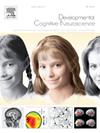早期认知控制发展的脑电图时频动态
IF 4.9
2区 医学
Q1 NEUROSCIENCES
引用次数: 0
摘要
认知控制对目标导向行为至关重要,对认知和社会情感发展的其他方面也至关重要。这篇综述探讨了认知控制的神经动力学何时以及如何出现和发展,重点是用于研究婴儿和儿童认知控制的脑电图测量。我们认为时频分析是唯一能够捕捉认知控制的两个不同组成部分:1)需要控制的检测,以及2)控制的实例化。研究表明,从婴儿期开始,在童年和青春期增加,额叶中部θ波和δ波的信号强度和一致性与检测控制需求的过程有关。对于控制实例,有证据表明,中额叶皮层和外侧额叶皮层之间的θ波段连接从儿童早期就存在。也有证据表明,中额波能量参与了婴儿期控制的实例化。我们进一步回顾了新出现的证据,这些证据表明,中额波的个体差异不仅与行为近端相关,而且对早期经历和精神病理风险的变化敏感,从而提供了一种将早期逆境与未来精神病理联系起来的神经机制。我们讨论了未来需要采取的步骤,包括新的范例、计算模型和脑电图的非周期/周期建模。本文章由计算机程序翻译,如有差异,请以英文原文为准。
EEG time-frequency dynamics of early cognitive control development
Cognitive control is crucial for goal-directed behavior, and essential for other aspects of cognitive and socioemotional development. This review examines when and how the neural dynamics of cognitive control emerge and develop, focusing on electroencephalography measures used to study cognitive control in infants and children. We argue that time-frequency analyses are uniquely able to capture two distinct components of cognitive control: 1) the detection that control is needed, and 2) the instantiation of control. Starting in infancy and increasing across childhood and adolescence, studies suggest the signal strength and consistency of midfrontal theta and delta oscillations are involved in processes that detect the need for control. For control instantiation, there is evidence that theta band connectivity between midfrontal and lateral-frontal cortices is present from early childhood. There is also evidence for the involvement of midfrontal theta power in the instantiation of control in infancy. We further review emerging evidence that indicates individual differences in midfrontal theta are not only proximally related to behavior, but also sensitive to variations in early experience and risk for psychopathology, providing a neural mechanism linking early adversity to future psychopathology. We discuss needed future steps, including novel paradigms, computational models, and aperiodic/periodic modeling of EEG.
求助全文
通过发布文献求助,成功后即可免费获取论文全文。
去求助
来源期刊

Developmental Cognitive Neuroscience
NEUROSCIENCES-
CiteScore
7.60
自引率
10.60%
发文量
124
审稿时长
6-12 weeks
期刊介绍:
The journal publishes theoretical and research papers on cognitive brain development, from infancy through childhood and adolescence and into adulthood. It covers neurocognitive development and neurocognitive processing in both typical and atypical development, including social and affective aspects. Appropriate methodologies for the journal include, but are not limited to, functional neuroimaging (fMRI and MEG), electrophysiology (EEG and ERP), NIRS and transcranial magnetic stimulation, as well as other basic neuroscience approaches using cellular and animal models that directly address cognitive brain development, patient studies, case studies, post-mortem studies and pharmacological studies.
 求助内容:
求助内容: 应助结果提醒方式:
应助结果提醒方式:


